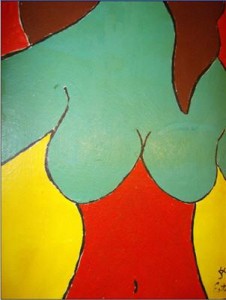 ESTEVES, ANTONIO
ESTEVES, ANTONIO
(1910–1983)
is one of many twentieth century self-taught artists who began to paint in their mature years, following retirement, the death of a spouse, illness, or an accident. He began painting to relieve persistent pain and a burning sensation in his hands, chest, and neck after a boiler explosion, about 1970, that severely injured those parts of his body. Esteves sketched his first picture, the outline of a rose, on a tablecloth. Satisfied with the result, Esteves added color to the drawing using house paint. Assuperintendent of a Brooklyn apartment building, located across the street from the Brooklyn Museum of Art, he often painted apartments, so leftover paint wasgenerally available. From 1973 until his death, he completed more than 150 pictures, as well as two plaster sculptures.Esteves painted primarily on discarded furniture, wooden boards, and Masonite. He prepared his surface with a coat of white paint, and then applied a coat of varnish after painting his picture. Esteves’s subjects ranged from still-lifes to portraits and landscapes; he was especially drawn to religious subject matter. Hismasterpiece,
The Crucifixion
(1978), was painted on an old circular tabletop. In this expressionistic interpretation, three centrally crucified figures are represented onan earth-toned ground, surrounded by onlookers. A swirling, dark sky is punctuated by an ominous orange-rimmed, blackened orb that activates the entire scene.Over each of the crucified figures, a pitchfork-shaped lightning flash pierces the sky in a downward thrust.Born in Rio de Janeiro, Brazil, Esteves was still a child when he moved to the United States with his family. His mother died when he was young and his father worked as a ship’s carpenter and on a Cuban sugar plantation. According to his family, from the time Esteves was twelve until he married, he had spent years living“under stoops.” He attended school through the sixth grade, then held a variety of jobs. He married in about 1930, and had five children. With the insurance settlementthat Esteves received from his boiler explosion accident, he purchased a building and invested in the Eastern Pet Company, a firm that imported exotic animals.Artistic recognition came to Esteves through the Brooklyn Museum of Art. In 1976 Esteves was represented in an annual community outdoor art show sponsored bythe museum. He sold three paintings at the show and won a prize for painting. The museum offered to display Esteves’s award-winning painting, and it was there thatStephen Gemberling, a New York City gallery owner, saw the work, and subsequently offered to become his agent.
See also
Painting, American Folk; Painting, Landscape; Painting, Still-life; Religious Folk Art
.
BIBLIOGRAPHY
Hemphill, Herbert W.Jr., and Julia Weissman.
Twentieth-Century American Folk Art and Artists.
New York, 1974.Johnson, Jay, and William C.Ketchum.
American Folk Art of the Twentieth Century.
New York, 1983.Rosenak, Chuck, and Jan Rosenak.
Museum of American Folk Art Encydopedia of Twentieth-Century American Folk Art and Artists.
New York, 1990
